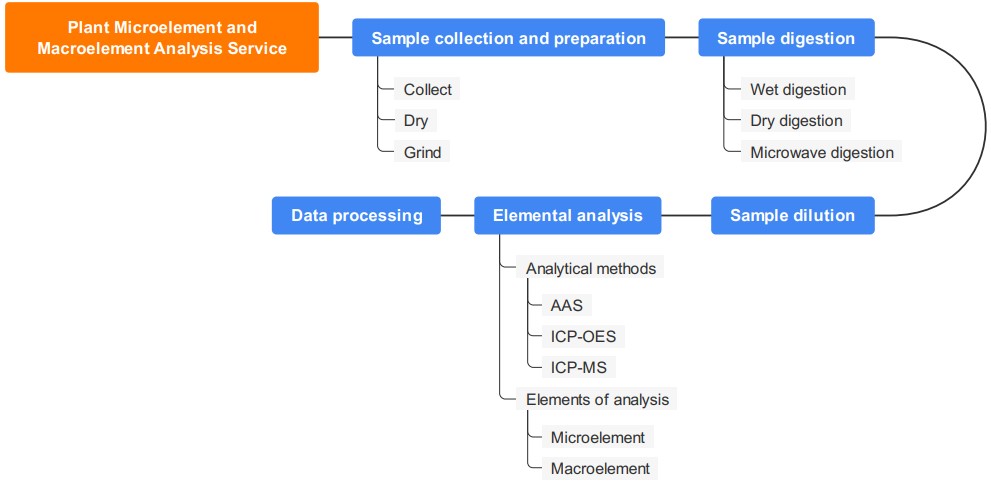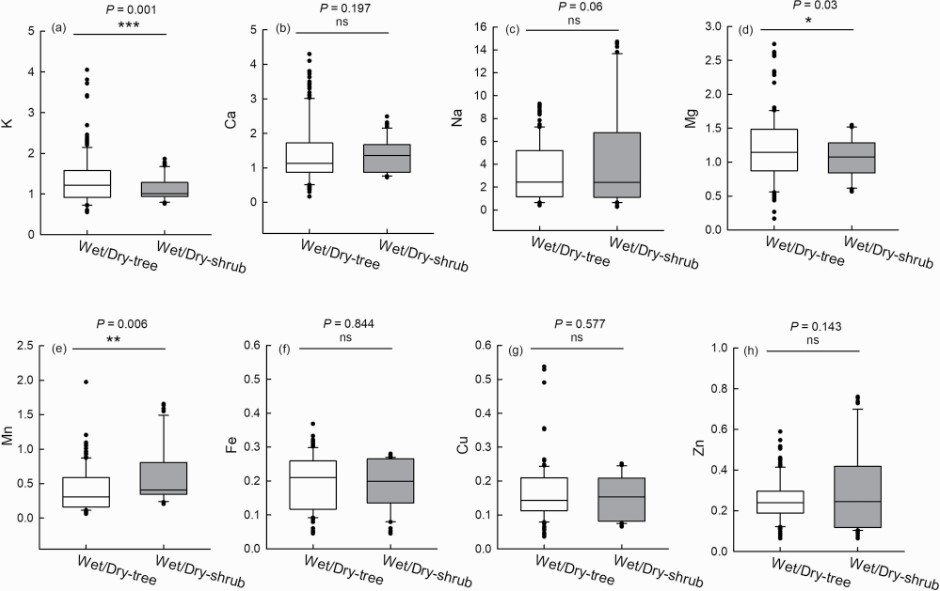Plant Microelement and Macroelement Analysis Service
Services Published Data FAQs Customer Review
Reliable Plant Micro- and Macroelement Analysis Service at Creative Biolabs
Biomass usually contains various microelements and macroelements. Analysis of micro and macroelements in plant biomass can provide important information that helps optimize agricultural production, assess the level of contamination in soil, study and control the quality of agricultural and food industry products, and ensure product safety. Creative Biolabs has accumulated rich project experience in the field of Biomass Profiling. We respond quickly to client needs and provide high-quality Plant Biomass Profiling services, including Pigment Profiling, Cell Wall Analysis, Vitamin Profiling, and element analysis.
Analysis of micro and macroelements in plant biomass typically requires the following steps:
-
Sample collection and preparation
We collect representative samples from plants such as leaves, stems, or roots. Place the sample in a well-ventilated environment to dry, and remove excess moisture to a constant weight. The dried sample is then ground into powder using a mortar or grinder to increase the uniformity and solubility of the sample.
We determine the most suitable sample digestion method according to the sample type, required elements, and the requirements of the subsequent analytical method.
-
Wet digestion: We mix the sample with strong acids (such as nitric acid, hydrofluoric acid, etc.) and heat it for digestion. This method is suitable for most plant samples and effectively converts organic matter into inorganic forms. After the sample is digested, the acid residue needs to be processed to avoid affecting subsequent analysis.
-
Dry digestion: We digest the sample through high-temperature combustion to oxidize the organic matter in the sample into gas, and finally obtain ash. This method is suitable for specific element requirements or experimental purposes, such as carbon, hydrogen, and nitrogen element analysis.
-
Microwave digestion: We place the sample in a microwave digestion tube, add appropriate digestion reagents, and digest the sample through a microwave digestion instrument. Microwave digestion helps to improve sample solubility and digestion efficiency.
We process the digested sample by dilution or other methods to make the element concentration in the sample suitable for subsequent analysis.
Digested plant biomass samples are analyzed for elements by a variety of analytical methods, such as:
-
Atomic absorption spectroscopy (AAS): It performs elemental analysis by measuring the ability of specific metal elements in a sample to absorb light of specific wavelengths. Elements that can be analyzed include sodium, potassium, magnesium, calcium, zinc, copper, iron, nickel, manganese, and other metal elements.
-
Inductively coupled plasma optical emission spectrometry (ICP-OES): It determines the element content by atomizing the sample, generating a high-temperature plasma, and analyzing the spectral lines of specific wavelengths emitted by the plasma. In addition to the elements that can be analyzed in AAS, it also analyzes elements such as phosphorus, aluminum, boron, and silicon.
-
Inductively coupled plasma mass spectrometry (ICP-MS): It atomizes and ionizes the sample, and then uses a mass spectrometer instrument to analyze elements. ICP-MS is more sensitive than ICP-OES, can detect elements at lower concentrations, and is more flexible in multi-element analysis, such as antimony, cadmium, chromium, cobalt, lead, molybdenum, titanium, and vanadium.
We add standard reference materials during the analysis process to ensure analytical accuracy. Moreover, the data obtained from the analysis are processed and analyzed, and the contents of various elements and related information are recorded.

Creative Biolabs pays attention to the latest biomass analysis technologies and methods, continuously improves technology, and is committed to providing clients with better biomass analysis services. If you would like to obtain plant biomass-related analysis services, please do not hesitate to contact us for a quotation. We will provide you with unparalleled analysis services.
Published data
Essential oils are widely applied in medicine, food, and fragrance industries, so assessing their quality and safety is particularly important. This study focused on essential oils and analyzed the levels of trace elements, harmful elements, and major elements in 34 essential oil products from different regions of the market. First, the authors collected target essential oil samples and placed them in a digestion solution consisting of nitric acid and hydrogen peroxide, and then digested them under high temperature, high pressure, and microwave conditions. Subsequently, they quantitatively analyzed the various elements in the sample solution using an inductively coupled plasma quadrupole mass spectrometer (ICP-MS). The significance of this study is that it can encourage consumers to choose products that meet their needs according to the content of each element detected. In addition, manufacturers can reduce the content of specific elements by improving the extraction process.
 Fig.1 Trace element content in various essential oil samples.1
Fig.1 Trace element content in various essential oil samples.1
FAQ
Q1: What micro and macroelements can be analyzed in my biomass sample?
A1: We analyze your samples for a range of micro and macroelements, including but not limited to iron, zinc, magnesium, calcium, potassium, etc. We provide corresponding elemental analysis services according to your needs and research purposes.
Q2: Is the content of these elements related to the source, processing method, or type of biomass?
A2: Yes, the source, processing method, and type of biomass will affect the elemental content in it. We will provide you with professional analysis services according to the sample information and research background you provide, and help explain the correlation between elemental content and biomass properties.
Q3: Can you provide custom microelement analysis solutions for different types of biomass samples?
A3: Yes, we will design a customized microelement analysis plan for you according to your biomass sample type and research needs to meet your specific requirements.
Customer Review
Accurate and Reliable Data
"The analytical data provided by Creative Biolabs is accurate and reliable, helping us to conduct in-depth research on the contents of various elements in substances. These data play a key role in our research."
Custom Solutions
"Thank you to Creative Biolabs for designing a custom microelement analysis plan for us, fully taking into account our research needs and the characteristics of the biomass samples, and providing us with very valuable data."
Reference
-
Iordache, Andreea Maria, et al. "Assessing the health risk and the metal content of thirty-four plant essential oils using the ICP-MS technique." Nutrients 14.12 (2022): 2363. Distributed under Open Access license CC BY 4.0, without modification.
For Research Use Only.
Related Services


 Fig.1 Trace element content in various essential oil samples.1
Fig.1 Trace element content in various essential oil samples.1

